The NASA Electronic Parts and Packaging (NEPP) '02 Workshop
The NASA Electronic Parts and Packaging (NEPP) '02 Workshop
The NASA Electronic Parts and Packaging (NEPP) '02 Workshop
You also want an ePaper? Increase the reach of your titles
YUMPU automatically turns print PDFs into web optimized ePapers that Google loves.
Abstracts ________________________<br />
Session 2 – Low Temperature Environments I<br />
<strong>Electronic</strong>s for Extremely Cold Environments: Enabling New<br />
Space Missions.<br />
Mike Newell, JPL<br />
Abstract<br />
<strong>The</strong> ability to operate Spacecraft electronics at extreme cold<br />
temperatures enables new classes of missions <strong>and</strong> allows for<br />
extending capabilities for aspects of traditional missions. Nanospacecraft<br />
<strong>and</strong> nano-sciencecraft require the use of extreme cold<br />
temperature electronics, as these systems do not have the<br />
resources to keep electronics warm. Implications of going to<br />
miniaturizing spacecraft are explored <strong>and</strong> an overview of the flight<br />
electronics design for the Muses-CN nano-rover is given. A<br />
summary of electronics components <strong>and</strong> considerations is given<br />
along with ways that cold temperature electronics can exp<strong>and</strong> the<br />
capabilities of regular sized spacecraft <strong>and</strong> science craft missions.<br />
Aspects of other effects of nano-spacecraft such as no mass for<br />
radiation shielding are discussed.<br />
Speaker Biography<br />
Michael Newell has fifteen years of experience designing digital<br />
<strong>and</strong> analog circuits for space flight. For the last five years he has<br />
been investigating operation of CMOS devices at cryogenic<br />
temperatures, in the <strong>NEPP</strong> Extreme <strong>Electronic</strong> Task <strong>and</strong> the<br />
Muses-CN Flight Project. His flight work includes design of<br />
integrated circuits for the Cassini Spacecraft, lead designer of the<br />
APEX flight experiment, the MUSES-CN electronics cognizant<br />
engineer, the Deep Impact Avionics Lead, <strong>and</strong> the electronics<br />
Cognizant Engineer for the LAMP 32-bit RISC processor board.<br />
His research work includes embedded systems for research<br />
robots, special purpose microcontrollers <strong>and</strong> leading the<br />
Gilgamesh super computer electronics design team at JPL. He<br />
holds a patent for his work on reconfigurable hardware for space<br />
processors. He has a BSEE from the California State Polytechnic<br />
University, Pomona.<br />
Extreme <strong>Electronic</strong>s: Cold Capacitor Characteristics<br />
Elaine Gee, JPL<br />
Abstract<br />
<strong>The</strong> extreme temperatures range (–170°C to 125°C ) seen by the<br />
MUSES-CN nanorover while roving on an asteroid is outside of the<br />
baseline temperature specifications for electronics parts. Ceramic<br />
capacitors are integral in digital <strong>and</strong> analog circuit design.<br />
Operation of space-rated ceramic capacitors outside of their –55°C<br />
to +125°C temperature range needed to be characterized. <strong>The</strong><br />
different physical properties between the BP <strong>and</strong> BX types of<br />
ceramic capacitors affect the performance <strong>and</strong> possible<br />
degradation of capacitance in temperature cycling. To test for<br />
MUSES-CN flight qualification, these BX <strong>and</strong> BP capacitors are<br />
operated <strong>and</strong> tested over a temperature range of –170°C to 125°C<br />
to determine capacitance variation with temperature <strong>and</strong> cycling<br />
variance. To explain cold ceramic capacitor characteristics, a<br />
model describes the capacitance variance in cold temperature <strong>and</strong><br />
validates use of ceramic capacitors for application for the extreme<br />
environments seen for the Muses-CN mission.<br />
11<br />
Speaker Biography<br />
Elaine Gee is currently an undergraduate at the California Institute<br />
of Technology in Pasadena, CA. As a physics major, she plans on<br />
pursuing graduate school after Caltech. She has worked for two<br />
summers at the Jet Propulsion Laboratory doing research in<br />
applied physics, particularly low temperature physics. She has<br />
worked with describing the behavior of ceramic surface mount<br />
capacitors as a function of low temperature <strong>and</strong> temperature<br />
cycling. She has also looked into hot carrier injection<br />
(HCI) mechanisms responsible for failures in metal-oxide<br />
semiconductor field effect transistors (MOSFETs) <strong>and</strong> proposed<br />
an alternative for dealing with HCI in these devices. In the future,<br />
she hopes to be involved in the space program as a career.<br />
Parameter Changes <strong>and</strong> Design Concerns of MOSFETs <strong>and</strong><br />
MOSFET based Circuits Operating at Extreme Cold (-170C)<br />
Temperatures.<br />
Ryan Stern, JPL<br />
Abstract<br />
Bipolar transistor based devices, which are readily available for<br />
commercial <strong>and</strong> space-rated use cannot be used below –55C due<br />
to carrier freeze out. Fortunately, MOSFET based devices have an<br />
even larger market share then bipolar parts <strong>and</strong> with some<br />
attention to detail can be made to work at temperatures down to –<br />
200C. Changes in MOSFET parameters including threshold<br />
voltage shift <strong>and</strong> carrier mobility have been modeled <strong>and</strong><br />
measured. Temperature dependence of propagation delay in<br />
CMOS digital devices was modeled <strong>and</strong> measured. Analog<br />
MOSFET-based devices were characterized at extreme cold<br />
temperatures. Along with the modeled <strong>and</strong> measures results, a<br />
general extreme cold temperature design philosophy <strong>and</strong> specific<br />
design rules are presented.<br />
Speaker Biography<br />
Ryan Stern is an associate engineer at the Jet Propulsion<br />
Laboratory. For the last five years, he has worked digital electronic<br />
circuit design. His work includes the design of a microcontroller for<br />
the DSII low voltage analog flight experiment, a high-speed serial<br />
FGPA for the LAMP spacecraft interface, <strong>and</strong> the 256 bit wide ALU<br />
design for the Gilgamesh Supercomputer project. On Muses-CN<br />
NanoRover electronics team, he ran spice simulations to analyze<br />
<strong>and</strong> verify models of extreme cold temperature operation of<br />
MOSFET <strong>and</strong> CMOS digital electronic devices including Radiation<br />
hardened ASICs. He received his B.A. degree in Physics from<br />
Pomona College, Claremont, CA, in 1999 <strong>and</strong> is currently working<br />
towards an M.S. degree in Electrical Engineering at the University<br />
of California, Los Angeles.<br />
Cryogenic Operation of Fully-Depleted SOI nFETs<br />
Jagdesh Patel, Auburn University<br />
Abstract<br />
This paper compares the effects of cryogenic temperature<br />
operation on fully-depleted SOI nFETs designed with two different<br />
gate layout structures. <strong>The</strong> observed subthreshold kink, as well as<br />
the output characteristic kink effect commonly associated with the<br />
regular gate nFETs, can both be effectively suppressed by using<br />
H-gate nFET layouts in combination with a grounded body tie.<br />
Body-floating H-gate nFETs show an unusual hysteresis effect at<br />
both room <strong>and</strong> low temperatures. Back gate bias can reduce the



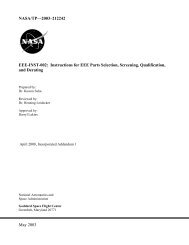

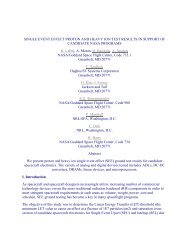
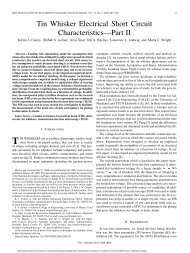
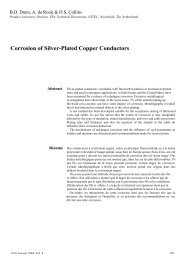
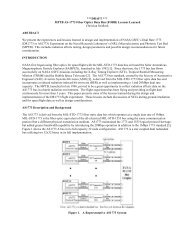

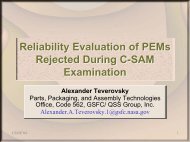
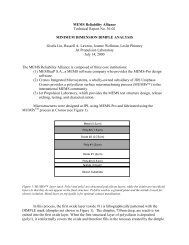
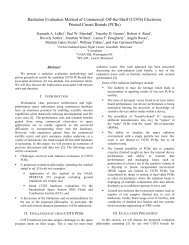
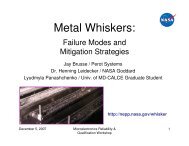
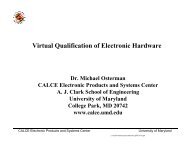
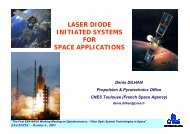
![mil-std-2223 [test methods for insulated electric wire] - NEPP](https://img.yumpu.com/4036001/1/190x249/mil-std-2223-test-methods-for-insulated-electric-wire-nepp.jpg?quality=85)